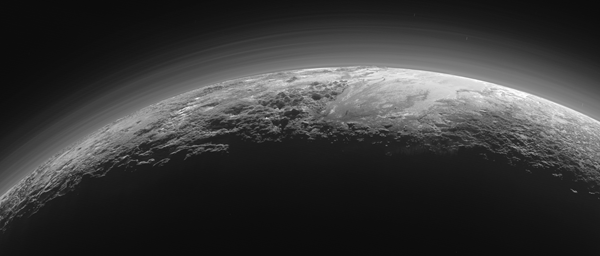This new view of Pluto’s crescent — taken by New Horizons’ wide-angle Ralph/Multispectral Visual Imaging Camera (MVIC) on July 14 and downlinked to Earth on Sept. 13 — offers an oblique look across Plutonian landscapes with dramatic backlighting from the sun. It spectacularly highlights Pluto’s varied terrains and extended atmosphere. The scene measures 780 miles (1,250 kilometers) across.
“This image really makes you feel you are there, at Pluto, surveying the landscape for yourself,” said New Horizons Principal Investigator Alan Stern, of the Southwest Research Institute in Boulder, Colorado. “But this image is also a scientific bonanza, revealing new details about Pluto’s atmosphere, mountains, glaciers and plains.”
Owing to its favorable backlighting and high resolution, this MVIC image also reveals new details of hazes throughout Pluto’s tenuous but extended nitrogen atmosphere. The image shows more than a dozen thin haze layers extending from near the ground to at least 60 miles (100 kilometers) above the surface. In addition, the image reveals at least one bank of fog-like, low-lying haze illuminated by the setting sun against Pluto’s dark side, raked by shadows from nearby mountains.
“In addition to being visually stunning, these low-lying hazes hint at the weather changing from day to day on Pluto, just like it does here on Earth,” said Will Grundy, lead of the New Horizons Composition team from Lowell Observatory, Flagstaff, Arizona.
Combined with other recently downloaded pictures, this new image also provides evidence for a remarkably Earth-like “hydrological” cycle on Pluto – but involving soft and exotic ices, including nitrogen, rather than water ice.










